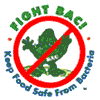
FDA/Center for Food Safety and Applied Nutrition
USDA/Food Safety and Inspection Service
October 2000; updated November 2004; slightly updated September 2006

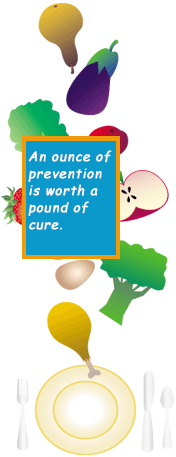
To Your Health!
Food Safety for Seniors
(Also available in PDF, 852 KB, and Spanish PDF, 669 KB)
Seniors have a lifetime of experience shopping, preparing and
eating food. And fortunately, Americans enjoy one of the safest most healthful food supplies
in the world. But a lot has changed over your lifetime--from the way food is produced and
distributed, to the way it is prepared and eaten.
What is also changing is your ability to fight-off dangerous bacteria that may invade your
body through the food you eat.
The good news is that well-known saying -- "An ounce of prevention is worth a pound of
cure" -- remains true. Preventing the growth of dangerous microorganisms in food is the key
to reducing the millions of illnesses and thousands of deaths each year.
You may already know a lot about how to prevent illness from mishandled food. Federal studies
show that older adults do a better job of handling food safely than any other age group. Even so, when
it comes to staying safe, you can never know too much.
This publication will help you learn more about what many of us call "food poisoning" -- the
experts call it foodborne illness. We'll look at:
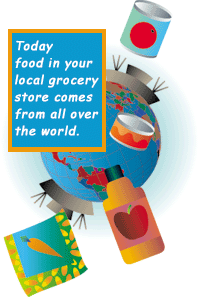
How Times Have Changed:
A lot has changed over your lifetime -- including the way food is produced
and distributed. It used to be that food was produced close to where people
lived. Many people shopped daily, and prepared and ate their food at home.
Eating in restaurants was saved for special occasions. Today, food in your local
grocery store comes from all over the world. And nearly 50 percent of the money
we spend on food goes to buy food that others prepare, like "carry out" and restaurant
meals.
Another thing that has changed is our awareness and knowledge of illnesses that can be
caused by harmful bacteria in food:
- Through science, we have discovered new and dangerous bacteria and viruses that can be
found in food -- bacteria we didn't even know about years ago.
- Science has also helped us identify illnesses that can be caused by bacteria and viruses in food -- illnesses we didn't recognize before. Today, for instance, we realize
that some illnesses, like some kinds of arthritis, can be traced to foodborne
illness.
One of the other things that we know today is that some people -- including
people over 65 -- can be more susceptible to getting sick from bacteria in food.
But seniors who take care to handle food safely can help keep themselves healthy.
Why Some People Face Special Risks:
Some people are more likely to get sick from harmful bacteria that can be found in food.
And once they are sick, they face the risk of more serious health problems, even death.
A variety of people may face these special risks -- pregnant women and young children,
people with chronic illnesses and weakened immune systems and older adults, including people
over 65.
Why are older adults more susceptible to foodborne illness?
Everyone's health is different, including his or her ability to fight off disease.
But immune systems weaken as we age. In addition, stomach acid also decreases as we
get older -- and stomach acid plays an important role in reducing the number of bacteria
in our intestinal tracts -- and the risk of illness.
Plus underlying illnesses such as diabetes, some cancer treatments, and kidney disease may
increase a person's risk of foodborne illness.
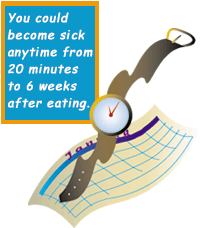
Recognizing Foodborne Illness:
It can be difficult for people to recognize when harmful bacteria in food have made them sick.
For instance, it's hard to tell if food is unsafe, because you can't see, smell or taste the bacteria
it may contain.
Sometimes people think their foodborne illness was caused by their last meal. In fact, there is a
wide range of time between eating food with harmful bacteria and the onset of illness. Usually foodborne
bacteria take 1 to 3 days to cause illness. But you could become sick anytime from 20 minutes to 6 weeks
after eating some foods with dangerous bacteria. It depends on a variety of factors, including the type of
bacteria in the food.
Sometimes foodborne illness is confused with other types of illness. If you get foodborne illness,
you might be sick to your stomach, vomit, or have diarrhea. Or, symptoms could be flu-like with a fever
and headache, and body aches. The best thing to do is check with your doctor. And if you become ill
after eating out, also call your local health department so they can investigate.
Foodborne illness can be dangerous, but is often easy to prevent. By following the basic rules
of food safety, you can help prevent foodborne illness for yourself and others.
Food Safety at Home
Just follow four basic rules -- Clean, Separate, Cook and Chill --
and you will Fight BAC!® (bacteria that can cause foodborne illness.)
Fight BAC!® is a national education campaign designed to teach everyone
about food safety. Keep these Fight BAC!® rules in mind. Tell your friends
and family and grandchildren to join the team and get them to be "BAC-Fighters" too.
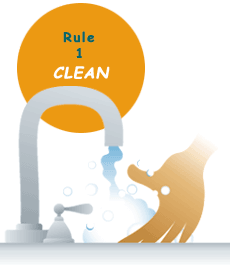
Clean: Wash hands and surfaces often
Bacteria can be present throughout the kitchen, including on cutting boards, utensils, sponges and counter
tops. Here's how to Fight BAC!®
- Wash your hands with warm water and soap before and after handling food and after using the bathroom,
changing diapers and handling pets.
- Wash your cutting boards, dishes, utensils and counter tops with hot water and soap after preparing
each food item and before you go on to the next food. Periodically, kitchen sanitizers (including a solution
of 1 tablespoon of unscented, liquid chlorine bleach to 1 gallon of water) can be used for added protection.
- Once cutting boards (including plastic, non-porous, acrylic and wooden boards) become excessively worn
or develop hard-to-clean grooves, you should replace them.
- Consider using paper towels to clean up kitchen surfaces. If you use cloth towels, wash them often in
the hot cycle of your washing machine.
- Also Important: Rinse raw produce in water. Don't use soap or other detergents. If necessary -- and
appropriate -- use a small vegetable brush to remove surface dirt.
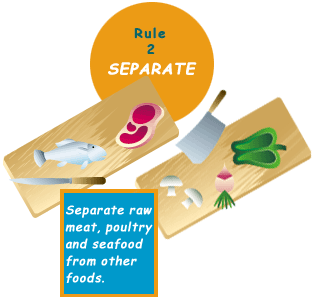
Separate: Don't cross-contaminate
Cross-contamination is the scientific word for how bacteria can be spread from one food product to another.
This is especially true when handling raw meat, poultry and seafood, so keep these foods and their juices away
from foods that aren't going to be cooked. Here's how to Fight BAC!®
- Separate raw meat, poultry and seafood from other foods in your grocery-shopping cart and in your refrigerator.
- If possible, use a different cutting board for raw meat, poultry and seafood products.
- Always wash cutting boards, dishes and utensils with hot, soapy water after they come in contact
with raw meat, poultry, seafood, eggs and unwashed fresh produce.
- Place cooked food on a clean plate. If you put cooked food on the unwashed plate that held raw food
(like meat, poultry or seafood), bacteria from the raw food could contaminate your cooked food.
Cook: Cook to proper temperatures
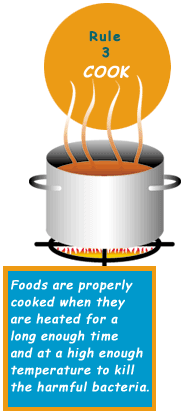
Food safety experts agree that foods are safely cooked when they are heated for a long enough
time and at a high enough temperature to kill the harmful bacteria that cause foodborne illness.
The best way to Fight BAC!® is to:
- Use a clean food thermometer, which measures the internal temperature of cooked foods, to make
sure meat, poultry, ® and other foods are safely cooked all the way through.
- Cook beef, veal, and lamb roasts and steaks to at least 145°F. Cook all poultry to a safe minimum internal temperature
of 165°F or to higher temperatures according to personal preference.
- Cook ground beef, where bacteria can spread during processing, to at least 160°F. Check the
temperature with a food thermometer.
- Cook eggs until the yolk and white are firm. Don't use recipes in which eggs remain raw or only
partially cooked.
- Fish should be opaque and flake easily with a fork.
- When cooking in a microwave oven, make sure there are no cold spots in food where bacteria can survive.
To do this, cover food, stir and rotate the dish by hand once or twice during cooking. (Unless you have a
turntable in the microwave.) Use a food thermometer to make sure foods have reached a safe internal temperature.
- If you are reheating food, leftovers should be heated to 165°F. Bring sauces, soup and gravy to a boil.
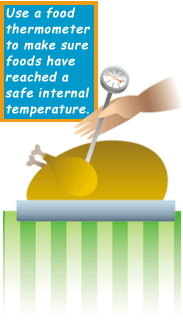
Apply the Heat!
Cooking food--especially raw meat, poultry, fish and eggs--to a safe minimum internal temperature kills harmful bacteria. Thoroughly cook food as follows*: |
| Raw Food |
Internal Temperature |
|
| Ground Products |
| Beef, veal, lamb, pork |
160°F |
| Chicken, turkey |
165°F |
|
|
Beef, Veal, Lamb Roasts & steaks
|
| medium-rare |
145°F |
| medium |
160°F |
| well-done |
170°F |
|
| Pork |
| Chops, roast, ribs |
| medium |
160°F |
| well-done |
170°F |
| Ham, fully cooked |
140°F |
| Ham, fresh |
160°F |
| Sausage, fresh |
160°F |
|
|
Poultry (Turkey & Chicken)
|
| Whole bird |
at least 165°F |
| Breast |
at least 165°F |
| Legs & thighs |
at least 165°F |
| Stuffing (cooked separately) |
165°F |
|
|
Eggs
|
| Fried, poached |
yolk & white are firm |
| Casseroles |
160°F |
| Sauces, custards |
160°F |
|
| Fish |
flakes with a fork |
|
| *This chart provides guidance for cooking foods at home. |
|
Thermometer Tips

|
Use a food thermometer to make sure foods have been properly cooked to a safe internal temperature.
Plus you won't over cook your food.
There are several types of thermometers available:
- Dial oven-safe: This type of thermometer is inserted into the
food at the beginning of the cooking time and remains in the food throughout cooking.
By checking the thermometer as the food cooks, you will know exactly when
thick cuts of meat, such as roasts or turkeys, are cooked to the safe temperature.
This type of thermometer is not appropriate for use with food that is thin, like
boneless chicken breast.
- Dial instant-read: This thermometer is not designed to
stay in the food during cooking.
When you think the food is cooked to the safe temperature, you check it
with the instant-read thermometer. To do this, insert the instant-read thermometer
into the thickest part of the food. Insert to the point marked on the probe--usually
to a depth of 2 inches. About 15 to 20 seconds are required for the temperature
to be accurately displayed.
This type of thermometer can be used with thin food, such as chicken breasts
or hamburger patty--simply insert the probe sideways, making sure that the tip
of the probe reaches the center of the meat.
- Digital instant-read: This type of thermometer does not
stay in the food during cooking--you check the temperature when you think the
food is cooked.
The advantage of this type of thermometer is that the heat-sensing device is in the tip of the probe.
Place the tip of the probe in the center of the thickest part of the food--at least 1/2 inch deep. About
10 seconds are required for the temperature to be accurately displayed.
This type of thermometer is good to use for checking the temperature of a thin food like a hamburger patty.
Just insert the probe from the top or sideways to a depth of 1/2 inch.
(FYI: Pop-up timers are reliable within 1 to 2 degrees, but it's best to check with a food thermometer.)
|
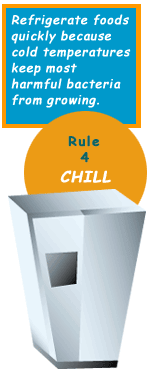
Chill: Did You Know?
At room temperature, bacteria in food can double every 20 minutes. The more bacteria there are, the greater
the chance you could become sick.
So, refrigerate foods quickly because cold temperatures keep most harmful bacteria from multiplying. A lot
of people think it will harm their refrigerator to put hot food inside--it's not true. It won't harm your
refrigerator and it will keep your food--and you--safe.
Set your home refrigerator to 40°F or below and the freezer unit to 0°F or below. Check the temperature
occasionally with an appliance thermometer.
Then, Fight BAC!® by following these steps:
- Refrigerate or freeze perishables, prepared food and leftovers within 2 hours
- Divide large amounts of leftovers into shallow containers for quick cooling in the refrigerator.
Safe Thawing:
Never thaw foods at room temperature. You can safely thaw food in the refrigerator. Four to five pounds
takes 24 hours to thaw.
You can also thaw food outside the refrigerator by immersing in cold water. Change the water every
half hour to keep the water cold. Cook immediately after thawing.
You can thaw food in the microwave, but if you do, be sure to continue cooking right away.
- Marinate foods in the refrigerator.
- Don't pack the refrigerator too full. Cold air must circulate to keep food safe.
Refrigerator and Freezer Storage Chart
|
| Eggs |
Refrigerator
(40°F) |
Freezer
(0°F) |
| Fresh, in shell |
4-5 weeks |
Don't freeze |
| Hardcooked |
1 week |
Doesn't freeze well |
| Egg substitutes, opened |
3 days |
Don't freeze |
| Egg substitutes, unopened |
10 days |
1 year |
|
| Dairy Products |
Refrigerator
(40°F)
|
Freezer
(0°F) |
| Milk |
1 week |
3 months |
| Cottage cheese |
1 week |
Doesn't freeze well |
| Yogurt |
1-2 weeks |
1-2 months |
| Commercial mayonnaise (refrigerate after opening) |
2 months |
Don't freeze |
| |
|
| |
Refrigerator
(40°F)
|
Freezer
(0°F)
|
| Vegetables
|
Raw |
Blanched/cooked |
| Beans, green or waxed |
3-4 days |
8 months |
| Carrots |
2 weeks |
10-12 months |
| Celery |
1-2 weeks |
10-12 months |
| Lettuce, leaf |
3-7 days |
Don't freeze |
| Lettuce, iceberg |
1-2 weeks |
Don't freeze |
| Spinach |
1-2 days |
10-12 months |
| Squash, summer |
4-5 days |
10-12 months |
| Squash, winter |
2 weeks |
10-12 months |
| Tomatoes |
2-3 days |
2 months |
|
| Deli Foods
|
Refrigerator
(40°F)
|
Freezer
(0°F)
|
| Entrees, cold or hot |
3-4 days |
2-3 months |
| Store-prepared or homemade salads |
3-5 days |
Don't freeze |
|
| Hot dogs & Luncheon Meats
|
Refrigerator
(40°F)
|
Freezer
(0°F)
|
| Hot dogs, opened package |
1 week |
|
| Hot dogs, unopened package |
2 weeks |
1-2 months in freezer wrap |
| Lunch meats, opened |
3-5 days |
1-2 months |
| Lunch meats, unopened |
2 weeks |
1-2 months |
|
| TV Dinners/Frozen Casseroles
|
Refrigerator
(40°F)
|
Freezer
(0°F)
|
| Keep frozen until ready to serve |
3-4 months |
|
| Fresh Meat |
Refrigerator
(40°F)
|
Freezer
(0°F)
|
| Beef-steaks, roasts |
3-5 days |
6-12 months |
| Pork-chops, roasts |
3-5 days |
4-6 months |
| Lamb-chops, roasts |
3-5 days |
6-9 months |
| Veal-roast |
3-5 days |
4-6 months |
|
| Fresh Poultry |
Refrigerator
(40°F)
|
Freezer
(0°F)
|
| Chicken or turkey, whole |
1-2 days |
1 year |
| Chicken or turkey pieces |
1-2 days |
9 months |
|
|
Fresh Fish
|
Refrigerator
(40°F)
|
Freezer
(0°F)
|
| Lean fish (cod, flounder, etc.) |
1-2 days |
6 months |
| Fatty fish (salmon, etc.) |
1-2 days |
2-3 months |
|
| Ham
|
Refrigerator
(40°F)
|
Freezer
(0°F)
|
| Canned ham (label says "keep refrigerated") |
6-9 months |
Don't freeze |
| Ham, fully cooked (Half & slices) |
3-5 days |
1-2 months |
|
|
Bacon & Sausage
|
Refrigerator
(40°F)
|
Freezer
(0°F)
|
| Bacon |
1 week |
1 month |
| Sausage, raw (pork, beef or turkey) |
1-2 days |
1-2 months |
| Pre-cooked smoked breakfast links/patties |
1 week |
1-2 months |
|
|
Leftovers
|
Refrigerator
(40°F)
|
Freezer
(0°F)
|
| Cooked meat, meat dishes, egg dishes, soups, stews and vegetables |
3-4 days |
2-3 months |
| Gravy and meat broth |
1-2 days |
2-3 months |
| Cooked poultry and fish |
3-4 days |
4-6 months |
|
|
Fresh Produce
- The quality of certain perishable fresh fruits and vegetables (such as strawberries, lettuce,
herbs and mushrooms) can be maintained best by storing in the refrigerator. If you are uncertain
whether an item should be refrigerated to maintain quality, ask your grocer.
- All produce purchased pre-cut or peeled should be refrigerated for safety as well as quality.
- Produce cut or peeled at home should be refrigerated within two hours.
- Any cut or peeled produce that is left at room temperature for more than two hours should be discarded
|
|
Special Foods/Special Advice
Some foods may contain bacteria that can be especially harmful to older adults and cause serious illness.
This section highlights foods older adults are advised not to eat. It also explains important safe food handling
tips for some ready-to-eat foods commonly found in the refrigerated section of your grocery store.
Foods Seniors are Advised Not to Eat
To reduce risks of illness from bacteria in food, seniors (and others who face special risks of illness)
are advised not to eat:
- Raw fin fish and shellfish, including oysters, clams, mussels, and scallops.
- Hot dogs and luncheon meats, unless they are reheated until steaming hot.
- Raw or unpasteurized milk or soft cheeses (such as Feta, Brie, Camembert, blue-veined,
and Mexican-style cheese) unless they are labeled "made with pasteurized milk".
- Refrigerated pates or meat spreads. Canned or shelf-stable pates and meat spreads may be eaten.
- Refrigerated smoked seafood unless it is contained in a cooked dish, such as a casserole.
Refrigerated smoked seafood, such as salmon, trout, whitefish, cod, tuna, or mackerel, is often
labeled as "nova-style," "lox," "kippered," "smoked," or "jerky." These products are found in the
refrigerator section or sold at deli counters of grocery stores and delicatessens. Canned or shelf-stable
smoked seafood may be eaten.
- Raw or lightly cooked egg or egg products containing raw eggs such as salad dressings, cookie or
cake batter, sauces, and beverages such as egg nog. (Foods made from commercially pasteurized eggs are
safe to eat.)
- Raw meat or poultry.
- Raw sprouts (alfalfa, clover, and radish)
- Unpasteurized or untreated fruit or vegetable juice (These juices will carry a warning label.)
- New information on food safety is constantly emerging. Recommendations and precautions are updated
as scientists learn more about preventing foodborne illness. You need to be aware of and follow the most
current information on food safety. See the information at the end of this document for ways to learn about
food safety updates.
|
Reheating ready-to-eat foods:
It's important to reheat some refrigerated foods that you buy pre-cooked. That's because these foods can become
re-contaminated with bacteria after they have been processed and packaged at the plant.
These foods include: hot dogs, luncheon meats, cold cuts, and other deli-style meat and poultry products that
are kept refrigerated.
- Reheat these foods until they are steaming hot. If you cannot reheat these foods, do not eat them.
- Wash your hands with warm, soapy water after handling these types of ready-to-eat foods.
(Wash for at least 20 seconds.) Also wash cutting boards, dishes and utensils with hot, soapy water. Thorough washing helps
eliminate any bacteria that might get on your hands or other surfaces from the food before it's been reheated.
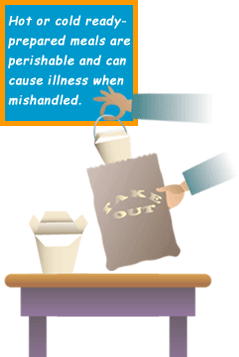
Eating Out, Bringing In
Let's face it. Sometimes it's just easier and more enjoyable to let someone else do the cooking.
And for today's older adults there are many eating options. All of these options, however, do have food
safety implications that you need to be aware of.
Bringing In: Complete Meals to Go and Home Delivered Meals
When you want to eat at home but don't feel like cooking or aren't able to, where do you turn?
- Many convenience foods, including complete meals to go, are increasingly popular.
- Purchased from grocery stores, deli stores or restaurants, some meals are hot and some are cold.
- Ordering home delivered meals from restaurants or restaurant-delivery services is an option many
consumers like to take advantage of.
- And of course, for those who qualify, there are programs like Meals on Wheels that provide a
ready-prepared meal each day.
Hot or cold ready-prepared meals are perishable and can cause illness when mishandled.
Proper handling is essential to ensure the food is safe.
The 2-Hour Rule
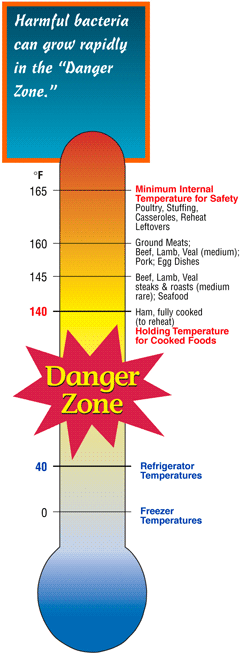
Harmful bacteria can multiply in the "Danger Zone" (between 40 and 140°F). So remember the
2-hour rule. Discard any perishable foods left at room temperature longer than 2 hours.
(When temperatures are above 90°F, discard food after 1 hour!)
Putting the 2-hour rule into action:
HOT FOODS: When you purchase hot cooked food, keep it hot. Eat and enjoy your food within 2 hours to
prevent harmful bacteria from multiplying.
If you are not eating within 2 hours--and you want to keep your food hot--keep your food in the oven
set at a high enough temperature to keep the food at or above 140°F. (Use a food thermometer to
check the temperature.) Side dishes, like stuffing, must also stay hot in the oven. Covering food will
help keep it moist.
However, your cooked food will taste better if you don't try to keep it in the oven for too long.
For best taste, refrigerate the food and then reheat when you are ready to eat. Here's how:
- Divide meat or poultry into small portions to refrigerate or freeze.
- Refrigerate or freeze gravy, potatoes, and other vegetables in shallow containers.
- Remove stuffing from whole cooked poultry and refrigerate.
COLD FOODS should be eaten within 2 hours or refrigerated or frozen for eating at another time.
Reheating?
You may wish to reheat your meal, whether it was purchased hot and then refrigerated or purchased cold initially.
- Heat the food thoroughly to 165°F.
- Bring gravy to a rolling boil.
- If heating in a microwave oven, cover food and rotate the dish so the food heats evenly and doesn't
leave "cold spots" that could harbor bacteria. Consult your owner's manual for complete instructions.
Eating Out
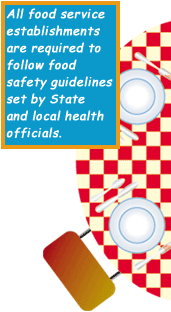
Whether you're eating out at a restaurant, a Senior Center, or a fast food diner, it can be both a
safe and enjoyable experience. All food service establishments are required to follow food safety guidelines
set by State and local health departments. But you can also take actions to insure your food's safety. Keep
these Fight BAC!® rules in mind: Clean, Cook, Chill.
Eating Out
Clean: When you go out to eat, look at how clean things are before you even sit down.
If it's not up to your standards, you might want to eat somewhere else.
Cook: No matter where you eat out, always order your food cooked thoroughly to a
safe internal temperature. Remember that foods like meat, poultry, fish, and eggs need to be cooked thoroughly
to kill harmful bacteria. When you're served a hot meal, make sure it's served to you piping hot and thoroughly
cooked, and if it's not, send it back.
Don't eat undercooked or raw foods, such as raw oysters or raw or undercooked eggs. Undercooked or raw eggs
can be a hidden hazard in some foods like Caesar salad, custards and some sauces. If these foods are made with
commercially pasteurized eggs, however, they are safe. If you are unsure about the ingredients in a particular
dish, ask before ordering it.
Chill

The Doggie Bag
It seems like meal portions are getting bigger and bigger these days. A lot of people are packing up these
leftovers to eat later. Care must be taken when handling these leftovers. If you will not be arriving home
within 2 hours of being served (1 hour if temperatures are above 90°F), it is safer to leave the leftovers at the restaurant.
Also, remember that the inside of a car can get very warm. Bacteria may grow rapidly, so it is always safer
to go directly home after eating and put your leftovers in the refrigerator.
Some Senior Centers that provide meals do not allow food to be taken away from the site because
they know how easy it is for bacteria to multiply to dangerous levels when food is left unrefrigerated too long.
Check with your center for its policy on taking leftovers home.
Those are the food safety rules--the way you can help yourself and others Fight BAC!®
Just remember: an ounce of prevention is worth a pound of cure.
If you have questions and you'd like to talk to an expert, please call the following toll-free hotlines:
The Food and Drug Administration Hotline can answer questions about safe handling of seafood, fruits and vegetables,
as well as rules that govern food safety in restaurants and grocery stores. You can reach them by calling:
1-888-SAFEFOOD.
The USDA Meat and Poultry Hotline can answer questions about safe handling of meat and poultry as well
as many other consumer food issues. Call them at 1-888-MPHotline (1-888-674-6854).
Or, on the World Wide Web
Consumer Advice for Seniors
www.FoodSafety.gov
|
Search/Subject Index
|
Disclaimers & Privacy Policy
|
Accessibility
Hypertext updated by dms/jbh/viv 2007-JUL-09














